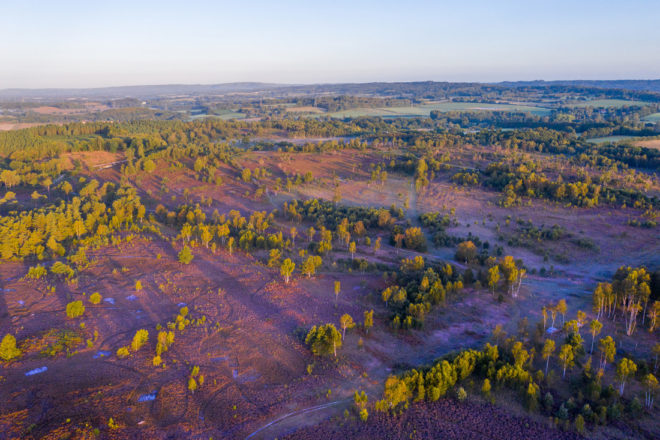Why our heaths are so special
May 6, 2020
Beth Nicholls, Heathlands Reunited Communities Outreach Officer, explains why heathlands are such an important British habitat that are worth conserving and enhancing.
 The South Downs National Park might not quite reach the coast on its western side, but walking along the white sandy tracks criss-crossing over our lowland heaths feels reminiscent of a stroll along the beach. This sandy soil provides the perfect basking spot for all six of our native species of reptile, including the very rare smooth snake.
The South Downs National Park might not quite reach the coast on its western side, but walking along the white sandy tracks criss-crossing over our lowland heaths feels reminiscent of a stroll along the beach. This sandy soil provides the perfect basking spot for all six of our native species of reptile, including the very rare smooth snake.
Insects such as solitary bees and ground beetles find it easy to build their burrows in the sand, and many insects such as butterflies and crickets feed on the nectar and leaves of heather. These insects themselves provide a tasty treat for ground-nesting birds such as the woodlark and heathland specialist the Dartford warbler.
In late spring nightjars also arrive back to nest on our heaths after their long migration from Africa, filling the dusk sky with their distinctive churring call. You can learn more about the wildlife living in this unique open landscape by watching our heathlands documentary on the National Park’s YouTube channel.
Lowland heath has actually been heavily shaped by the activity of humans over thousands of years. The characteristic sandy soil results from the clearing of large areas of dense forest that once covered the South of England by neolithic humans. This was to make space to grow crops and graze their animals, but eventually the removal of trees led to the erosion of the top soil.
The sandy soil that remained was too dry and nutrient-poor for growing crops, which allowed plants adapted to these conditions, like heather, to flourish. As farming practices have changed over time, heaths have lost their value as grazing sites and places to harvest raw materials such as wood, and without proper management they are under threat of turning back into forests, leading to the loss of all the special plants and animals that depend on this habitat.
England is home to approximately one fifth of all the heathland in Europe, and sadly 85% of the original heathland in the national park has been lost.
The Heathlands Reunited project, now in its fourth year, is a partnership of 11 organisations, led by the South Downs National Park Authority, that aims to expand, create new and improve existing heathland to cover an area greater than 1,200 football pitches. Currently heathland covers just one per cent of the South Downs National Park, and is mostly separated into ‘islands’ where isolated plants and animals are far more vulnerable to local extinction. The project aims to reengage and inspire communities to visit their heathlands, learn more about them and work together to look after them so they can be enjoyed for generations to come.
To find out more visit visit: www.southdowns.gov.uk/heathlands-reunited

